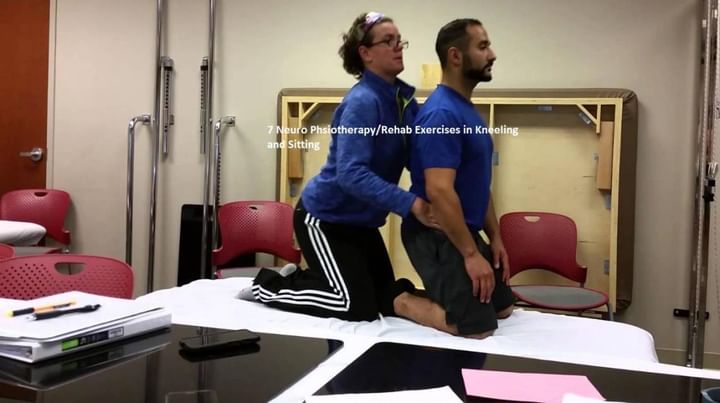7 Neuro Phsiotherapy/rehab Exercises in Kneeling and Sitting
EXERCISES IN PRONE LYING AND KNEELING
Patient kneeling.
He is asked to lift sound arm so that all pressure comes to the affected side. Poor balance and arm support on left affected side. Rocking backwards and forward , balancing on affected knee.
Patient kneel-standing.
Weight is on affected side but note slight retraction on affected side.
EXERCISES IN SITTING
Weight bearing on the affected upper limb:
The therapist sits behind the patient and maintains the arm in slight abduction and extension with elbow extension. The patient should be encouraged to weight bear with the arm in this position. As the patient improves the support given by the therapist should be gradually reduced.Facilitating weight transmission through affected side.
Shoulder shrugs:
- This exercises help the patient to achieve scapular elevation. The therapist may place her hand on the shoulder girdle to give a tactile input.
- Touching the opposite shoulder and placing the hand on sacrum: The patient is trained to touch the opposite shoulder in supination and then take it behind the back as far across as possible to the opposite side.
- In sitting position some exercises for the hand can be given emphasizing more on the extension components.
- Visual feedback exercises like holding a paper glass with water in it such that the water level should not increase or holding a clay mould without causing hand impression are some of the ways to train control of the hand.
- Supination- pronation by keeping the elbow flexed at 90 degree.
- Knee extension and flexion of knee: The patient should be asked to flex the knee by taking the foot as much as possible below the chair and then straightening it.
- Getting up: The patient is trained to perform getting up by moving the foot closer to the chair, bending forward, holding the hand rest and then getting up.
- Vestibular exercises: The patient may be made to sit on the vestibular ball to improve the balance and also normalize the tone of the trunk. Vestibular ball may be used to exercise the upper extremities mainly to achieve control at the proximal joint and facilitate extension of the fingers through stimulation of the proprioceptors at all the joints of the upper limb.



+1.svg)
